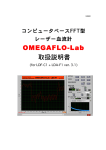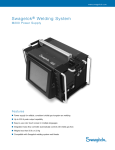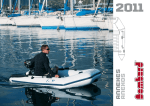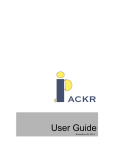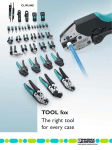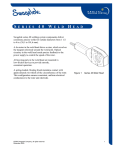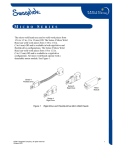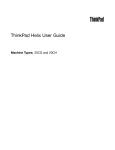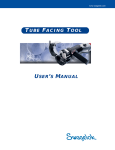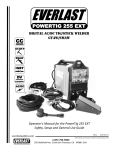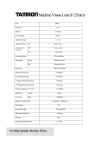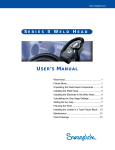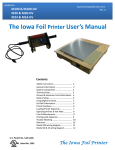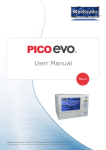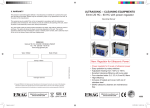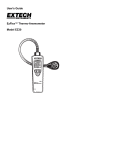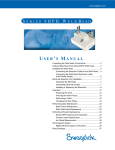Download Series 20 Weld Head User`s Manual (SWS-MANUAL
Transcript
www.swagelok.com S E R I E S 20 W E L D H E A D USER’S MANUAL Weld Head ......................................................... 1 Fixture Block ...................................................... 1 Unpacking the Weld Head Components ............ 2 Installing the Weld Head .................................... 3 Installing the Electrode in the Weld Head .......... 4 Calculating Arc Gap Gage Settings ................... 6 Setting the Arc Gap ........................................... 7 Fixturing the Work............................................ 12 Maintenance .................................................... 19 Parts Drawings ................................................ 29 The Swagelok Limited Lifetime Warranty Swagelok hereby warrants to the purchaser of this Product that the non-electrical components of the Product shall be free from defects in material and workmanship for the life of the Product. All electrical components installed in or on the Product are warranted to be free from defects in material and workmanship for twelve months from the date of purchase. The purchaser’s remedies shall be limited to replacement and installation of any parts that fail through a defect in material or workmanship. MANUFACTURER SPECIFICALLY DISAVOWS ANY OTHER REPRESENTATION, EXPRESS OR IMPLIED, WARRANTY, OR LIABILITY RELATING TO THE CONDITION OF USE OF THE PRODUCT, AND IN NO EVENT SHALL SWAGELOK BE LIABLE TO PURCHASER, OR ANY THIRD PARTY, FOR ANY DIRECT OR INDIRECT CONSEQUENTIAL OR INCIDENTAL DAMAGES. Series 20 Weld Head S E R I E S 20 W E L D H E A D Weld Head The Series 20 SWS weld head delivers consistent, precise welds for outside diameters from 1/2 to 2 in. (12 to 52 mm). A DC motor in the weld head drives a rotor, which carries the tungsten electrode around the weld joint. Optical circuitry in the weld head sends precise feedback to the power supply to control the speed of the rotor. All moving parts in the weld head are mounted in lowfriction devices to provide smooth, consistent operation. A spring-loaded, floating brush continuously contacts approximately one-third of the circumference of the rotor. This configuration ensures consistent, uniform electrical conductance to the rotor and electrode. Figure 1 Series 20 Weld Head Fixture Block The Series 20 SWS fixture block accurately aligns and holds tubing, fittings, and valve bodies. The modular design allows you to select different side plates and create the configuration needed for the job. The fixture block is separate from the weld head, allowing work pieces to be easily aligned and fixtured before welding. Using multiple fixture blocks can increase productivity. Each fixture block is designed to accommodate a range of work piece sizes. A unique and patented Universal Collet Insert (UCI) fits into the fixture block to match the diameter of the work piece. The collet design firmly holds tubing and fittings that vary ± 0.005 in. (0,13 mm) from nominal outside diameter. Collets are also available for thin wall pipe. The collets exchange quickly, making the fixture block very adaptable to changing work requirements. © 2001, 2004 Swagelok Company, all rights reserved April 2004 Figure 2 Series 20 Fixture Block 1 Series 20 Weld Head Unpacking the Weld Head Components The following weld head components are packaged in a foam-lined shipping container: • weld head • arc gap gage • electrode package • tool package 1. Inspect the container for damage. 2. Remove the components from the container. 3. Check the items for any damage. 4. Verify that the weld head serial number matches the serial number on the shipping container. 5. Record the model and serial numbers, and the delivery dates on page 7 of the Regulatory Module. 2 © 2001, 2004 Swagelok Company, all rights reserved April 2004 Series 20 Weld Head Installing the Weld Head Fixture Electrode The weld head has four connectors that plug into the power supply. See Figure 3. Work The four connectors on the cable are: • fixture • electrode (red) • work (green) • weld head shielding gas Weld Head Shielding Gas Figure 3 Weld Head Connect the four connectors to the rear panel of the power supply by performing the following steps (see Figure 4): 1. Locate the weld head. 2. Align the notch on the multi-pin connector with the small tab in the mating socket on the rear panel labeled FIXTURE. Insert the connector in the socket. Turn the connector sleeve clockwise by hand until it is tight. This connection provides the control signals to drive the weld head. 3. Insert and fully seat the red connector into the socket on the rear panel labeled ELECTRODE. Twist the connector 1/4-turn clockwise to lock it into place. This connection is the negative (-) terminal of the weld head. 4. Insert the green connector into the socket on the rear panel labeled WORK. Twist the connector 1/4-turn clockwise to lock it into place. This connection is the positive (+) terminal of the weld head. 5. Insert the weld head shielding gas connector into the Swagelok Quick-Connect stem labeled TO WELD HEAD. Ensure that the connector is firmly attached. This connection provides shielding gas to the weld head through a solenoid valve in the power supply. © 2001, 2004 Swagelok Company, all rights reserved April 2004 Figure 4 Weld Head Connectors Caution! Ensure that the fixture connector is fully seated in the mating socket and the threaded sleeve is tight. Note: The weld head shielding gas connector must be a single-end shut-off (SESO) Swagelok Quick-Connect stem (SS-QC4-S-400). 3 Series 20 Weld Head Installing the Electrode in the Weld Head This Swagelok weld head comes with a selection of electrodes. The following instructions show how to properly install an electrode in the weld head. Selecting the Proper Electrode Electrode length and diameter depend on your weld head model and the outside diameter of the work piece being welded. To select the correct electrode use the Electrode Selection Table. Table 1 D Electrode Selection Table Component OD 1/2 in. 3/4 in. 12 mm 18 mm 22 mm CWS-C.062-1.380-P 1 in. 1 1/4 in. 23 mm 25 mm 28 mm 35 mm CWS-C.062-1.105-P 1 1/2 in. 35 mm CWS-C.062-.855-P 1 3/4 in. 2 in. 35 mm 40 mm 52 mm Electrode Part No. CWS-C.062-1.630-P 4 L Electrode Length (L) 1.630 in. (41,40 mm) Electrode Diameter (D) 0.062 in. (1,57 mm) 3/4 1 1.380 in. (35,05 mm) 0.062 in. (1, 57 mm) 1 1/4 1 1/2 1.105 in. (28,07 mm) 0.855 in. (21,72 mm) 0.062 in. (1,57 mm) 0.062 in. (1,57 mm) Pipe 1/4 1/2 3/8 © 2001, 2004 Swagelok Company, all rights reserved April 2004 Series 20 Weld Head Electrode Geometry This illustration shows the electrode shape Swagelok suggests. Properly ground electrodes provide consistent, repeatable welds. Pre-ground electrodes are available from your Swagelok representative. See your parts list for ordering information. The electrode part numbers are assigned as follows: SWS – X.### - #.### - ### - P Figure 5 Electrode Diameter Material Designator C = Ceriated T = Thoriated Tungsten Electrode Package Designator Electrode Length Tip Diameter The ceriated electrode material type is a mixture of 98 % tungsten and 2 % cerium and is commonly referred to as “2 % ceriated.” This electrode type has demonstrated improved arc starting performance over the 2 % thoriated type, particularly when using purified shielding gas. © 2001, 2004 Swagelok Company, all rights reserved April 2004 5 Series 20 Weld Head Calculating Arc Gap Gage Settings To determine the arc gap gage setting for a specific arc gap, use the formula below. B A C B 2 A 2 C ARC GAP GAGE SETTING Where A = largest OD on the weld end of the tubing or fitting (welding diameter). B = Arc gap gage diameter C = desired arc gap Figure 6 Arc Gap Gage Setting Formula Example No. 1: (Series 20 Weld Head) 1 to 1 in. tube butt weld largest outside diameter A = 1.000 in. Arc gap gage diameter B = 3.118 in. Desired arc gap C = 0.025 in. 1.000 in. 2 + 3.118 in. 2 + 0.025 in. = 2.084 in. Example No. 2: (Series 20 Weld Head) 25 to 25 mm tube butt weld largest outside diameter A = 25,00 mm Arc gap gage diameter Desired arc gap B = 79,20 mm C = 0,50 mm 25,00 mm 2 6 + 79,20 mm 2 + 0,50 mm = 52,60 mm © 2001, 2004 Swagelok Company, all rights reserved April 2004 Series 20 Weld Head Setting the Arc Gap A The proper arc gap setting facilitates control of the weld and improves consistency. The following steps cover how to set the arc gap. The arc gap is set by using the arc gap gage provided with the weld head. The gage is adjusted for the desired arc gap and then installed in the rotor. With the gage in place, the electrode can be positioned with reasonable accuracy. Setting the Arc Gap Gage B 1. Measure the outside diameters of the work pieces being welded using a caliper or micrometer. See Figure 7(A). The M100 will calculate the arc gap gage setting automatically when using the Auto Entry feature. 2. Refer to the table for your nominal OD. Find the “actual” outside diameter nearest to your measurement. © 2001, 2004 Swagelok Company, all rights reserved April 2004 Figure 7 Setting an Arc Gap gage 7 Series 20 Weld Head Table 2 SWS-20H-C Arc Gap Gage Dia. 3.118 in. Nominal OD (in.) Actual OD (in.) Setting for 0.030 in. Arc Gap (in.) 1/2 3/4 1 1 1/4 1 1/2 2 .500 .750 1.000 1.250 1.500 2.000 1.839 1.964 2.089 2.214 2.339 2.589 Table 3 Setting for 0.070 in. Arc Gap (in.) Setting for 0,5 mm Arc Gap (mm) Setting for 0,64 mm Arc Gap (mm) Setting for 0,76 mm Arc Gap (mm) Setting for 1,02 mm Arc Gap (mm) Setting for 1,14 mm Arc Gap (mm) 1.849 1.974 2.099 2.224 2.349 2.599 1.859 1.984 2.109 2.234 2.359 2.609 1.869 1.994 2.119 2.244 2.369 2.619 1.879 2.004 2.129 2.254 2.379 2.629 46,45 49,63 52,80 55,98 59,15 65,50 46,59 49,77 52,94 56,12 59,29 65,64 46,97 49,89 53,06 56,24 59,41 65,76 46,97 50,15 53,32 56,50 59,67 66,02 47,09 50,27 53,44 56,62 59,79 66,14 Setting for 0,50 mm Arc Gap (mm) 46,12 49,12 51,12 51,62 52,62 54,12 57,62 66,12 Setting for 0,64 mm Arc Gap (mm) 46,26 49,26 51,26 51,76 52,76 54,26 57,76 66,26 Setting for 0,76 mm Arc Gap (mm) 46,38 49,38 51,38 51,38 52,88 54,38 57,88 66,38 Setting for 1,02 mm Arc Gap (mm) 46,64 49,64 51,64 51,64 53,14 54,64 58,14 66,64 Setting for 1,14 mm Arc Gap (mm) 46,76 49,76 51,76 51,76 53,26 54,76 58,26 66,76 Setting for 0.060 in. Arc Gap 1.889 1.957 2.039 2.144 2.277 2.449 2.569 Setting for 0.070 in. Arc Gap 1.899 1.967 2.049 2.154 2.287 2.459 2.579 Setting for 1,52 mm. Arc Gap 46,22 1,957 49,72 50,57 51,77 54,57 57,97 62,32 65,27 Setting for 1,78 mm. Arc Gap 46,48 1,967 49,98 50,83 52,03 54,83 58,23 62,58 65,53 SWS-20H-C Pipe Arc Gap Gage Settings (standard) Actual OD (in.) 0.54 0.675 0.84 1.05 1.315 1.66 1.9 Setting for 0.030 in. Arc Gap 1.859 1.927 2.009 2.114 2.247 2.419 2.539 Setting for 0.040 in. Arc Gap 1.869 1.937 2.019 2.124 2.257 2.429 2.549 Setting for 0.050 in. Arc Gap 1.879 1.947 2.029 2.134 2.267 2.439 2.559 SWS-20H-C Pipe Arc Gap Gage Settings (metric) Pipe Size (mm.) 10,2 13,5 17,2 18,9 21,3 26,9 33,7 42,4 48,3 8 Setting for 0.060 in. Arc Gap (in.) Actual OD (mm) 12,00 18,00 22,00 23,00 25,00 28,00 35,00 52,00 Pipe Size (in.) 1/4 3/8 1/2 3/4 1 1 1/4 1 1/2 Table 5 Setting for 0.050 in. Arc Gap (in.) SWS-20H-C Arc Gap Gage Dia. 79,20 mm. Nominal OD (mm) 12 18 22 23 25 28 35 52 Table 4 Setting for 0.040 in. Arc Gap (in.) Actual OD (mm.) 10,2 13,5 17,2 18,9 21,3 26,9 33,7 42,4 48,3 Setting for 0,76 mm. Arc Gap 45,46 47,11 48,96 49,81 51,01 53,81 57,21 61,56 64,51 Setting for 1,02 mm. Arc Gap 45,72 1,937 49,22 50,07 51,27 54,07 57,47 61,82 64,77 Setting for 1,27 mm. Arc Gap 45,97 1,947 49,47 50,32 51,52 54,32 57,72 62,07 65,02 © 2001, 2004 Swagelok Company, all rights reserved April 2004 Series 20 Weld Head Inserting the Electrode into a Rotor 1. Without the fixture block attached, press WELD on the operator panel. 2. Use JOG to position the rotor as shown in Figure 8. 3. Loosen the two electrode clamping screws. If you are replacing the electrode, remove the electrode. 4. Insert the new electrode, with the sharp tip pointing out. Tighten the electrode clamping screws slightly to hold it in place temporarily. 5. Set the proper arc gap with the arc gap gage. Electrode Clamping Screws Figure 8 Electrode Installation WARNING! DO NOT PRESS START WHILE TOUCHING THE ELECTRODE. Caution! Do not jog or move the rotor unless the electrode is clamped in place. © 2001, 2004 Swagelok Company, all rights reserved April 2004 9 Series 20 Weld Head Setting the Arc Gap A B 1. Use JOG to position the rotor as shown. This allows access to the electrode clamping screws. 2. Insert the arc gap gage into the rotor. See Figure 9(A). 3. Tilt the weld head upward. Loosen the electrode screw allowing the electrode to drop onto the gage surface. See Figure 9(B). 4. Tighten the electrode clamping screws just enough to secure the electrode. Remove the arc gap gage. 5. Press HOME to return the rotor to the home position. Figure 9 Setting the Arc Gap Caution! Do not jog or move the rotor unless the electrode is clamped in place. 10 © 2001, 2004 Swagelok Company, all rights reserved April 2004 Series 20 Weld Head Preparing the Work It is important to prepare the tube pieces properly before welding. Refer to Figure 10. Tubing must be square and burr-free to ensure repeatable, high-quality autogenous fusion welds. Cut the tubing to length with a hacksaw or tube cutter. Face the tube ends with a lathe or a portable facing tool. Deburr the ends, making sure that both the inside and outside diameters are square and burrfree. Clean the tube ends using an appropriate solvent. Minimize the chance of a poor quality weld by following these guidelines: • Tube ends must be square. • Tube ends must not have a wall thickness variation exceeding ± 15 % of nominal. • Tube ends must be burr-free. • Tube ends must be free of any rust, grease, oil, paint, or other surface contaminates. Method Result Burrs in Flow Path Burrs Hack Saw Cut Gap End Rolled by Cutter Blade and Roller Irregular Tube Diameter Tube Cutter Burrs Face Perpendicular to Axis Reduced Flow Area Smooth Transition at Wall Faces Tube Facing Tool Square Corners No Gaps Figure 10 Tube Preparation © 2001, 2004 Swagelok Company, all rights reserved April 2004 11 Series 20 Weld Head Fixturing the Work Select or configure the appropriate fixture block. Select the collets to match the work outside diameter. Selecting the Fixture Block and Collets 1. Select the fixture block that accepts the outside diameter of the tube to be welded. Refer to Table 6. Table 6 Fixture Blocks Model SWS-20TFB-A OD Capacity 1/2 to 2 in. (12 to 52 mm) 1/2 to 2 in. (12 to 52 mm) SWS-20FSP1L or SWS-20FSP1R Minimum Weld Extension Length 1.45 in. (36,83 mm) 0.80 in. (20,32 mm) 2. Select the proper collets for the diameter of the parts being welded. Refer to Table 7. Table 7 Collets Model CWS-20UCI-X OD Capacity 1/2 in. to 2 in. (12 mm to 48.3 mm) CWS-20UCI-XP 1/4 to 1 1/2 Comments Tubing/ tube fittings Pipe Add J suffix for JIS pipe (-XPJ) Add MMP suffix for metric pipe (-XMMP) SWS-20UCI-XTN 1/2 in. to 2 in. (12 mm to 52 mm) SWS-20UCI-MC N/A 12 Tubular weld fitting collet for SWS-20FSP1L and SWS-20FSP1R Add MM (XMMTN) suffix for metric sizes Collet to hold ferrule mandrels for SWS-20TFB-A fixture block Where X identifies the collet size in 1/16ths or metric (MM suffix) © 2001, 2004 Swagelok Company, all rights reserved April 2004 Series 20 Weld Head Installing the Collets in a Tube Fixture Block 1. Release both levers and open the tube fixture block. See Figure 11. Figure 11 Opening the Fixture Block © 2001, 2004 Swagelok Company, all rights reserved April 2004 13 Series 20 Weld Head 2. Install the collet halves in both the top and bottom side plates and tighten the collet screws. Make sure the collet shoulder is flush against the fixture side plate. See Figure 12. A B Fixture Side Plate Collet Shoulder Figure 12 Installing Collets 14 © 2001, 2004 Swagelok Company, all rights reserved April 2004 Series 20 Weld Head Aligning the Work Pieces in the Tube Fixture Block 1. Place the centering gage in one side of the tube fixture block. The centering gage must span the width of the collet. Verify that the centering gage is positioned correctly for either the thick or thin side plate. See Figure 13. 2. Butt one work piece against the centering gage. See Figure 14(A). 3. Lock down the top side plate. See Figure 14(B). 4. Remove the centering gage. Figure 13 Place the Centering Gage Note: When welding a Swagelok ATW fitting to tubing, butt the tubing against the centering gage first. A B Figure 14 Placing First Work Piece in the Fixture Block © 2001, 2004 Swagelok Company, all rights reserved April 2004 15 Series 20 Weld Head 5. Butt the second work piece against the first work piece, and lock down the top side plate. See Figure 15. 6. Inspect 360° around the weld joint for fit and alignment. If the alignment is not correct proceed to the next section for alignment adjustment instructions. Figure 15 Placing Second Work Piece 16 © 2001, 2004 Swagelok Company, all rights reserved April 2004 Series 20 Weld Head Adjusting the Fixture Block The modular design of the Series 20 Fixture Block allows you to assemble the block to meet a variety of welding requirements. To align tubing in the SWS-20TFB-A Fixture Block follow these steps: 1. Loosen the alignment knobs. See Figure 16. 2. Align the tubing with the fitting. See Figure 17. 3. Tighten the alignment knobs. Alignment Knobs Figure 16 Loosen the Alignment Knobs Align Fitting with Tubing Alignment Knob Figure 17 Aligning the Tubing © 2001, 2004 Swagelok Company, all rights reserved April 2004 17 Series 20 Weld Head Mating the Weld Head to the Fixture Block 1. Rotate the locking lever on the weld head counter-clockwise until it stops. See Figure 18. 2. Insert the weld head into the fixture block. See Figure 19(A). 3. Rotate the locking lever clockwise to secure the weld head. See Figure 19(B). Figure 18 Releasing the Locking Lever Operating the Weld Head Operate the weld head using the following parameters: Shield Gas Flow Rate std ft3/hr (std L/min) A 20 to 40 (9,4 to 18,8) Prepurge and Postpurge Minimum Time in Seconds 30ཱ Start Power Normal Maximum Recommended Average Amps 70 Amps at 50% Duty Cycle Set flow to higher rates when welding at high currents. ཱ Flow should be continuous for cooling when welding at high currents. B Figure 19 Mating the Weld Head to the Fixture Block 18 © 2001, 2004 Swagelok Company, all rights reserved April 2004 Series 20 Weld Head Maintenance To ensure your Swagelok Welding System (SWS) equipment is always in proper working order, you must perform periodic maintenance on the system components. This section describes the procedures necessary for maintaining the fixture blocks and weld heads. Note: If you experience problems while performing the procedures in this section, refer to the Troubleshooting manual or contact your Swagelok representative. For detailed part drawings and information, refer to the Parts Drawings section at the end of this manual. Perform fixture block maintenance daily and after every 40 hours of welding time. Depending on usage and wear, maintenance may be performed before the 40-hour interval. © 2001, 2004 Swagelok Company, all rights reserved April 2004 19 Series 20 Weld Head Fixture Block Daily Maintenance Non-Anodized Surfaces Under the Collets At the start of each work day: B 1. Inspect the fixture block for cleanliness, wear and damage. See Figure 20. 2. Remove dirt, carbon, and vapor deposits from the fixture block with a clean, soft cloth. A solvent such as alcohol or acetone can be used. Remove heavier deposits with a fine-grit abrasive pad. At the end of each workday, clean and store the fixture block in a dry place. Inside C Plate Surfaces A Collets Fixture Block Periodic Maintenance Every 500-700 welds: 1. Inspect and clean the collets. See Figure 20(A). 2. Check for scratches and dents. 3. Remove dirt and oxides from all surfaces of the collet with a soft stainless steel wire brush. Figure 20 Cleaning the Collets and Collet Mounting Surfaces Latch 4. Remove any oxides from the non-anodized mating surfaces of the side plates with a fine-grit abrasive pad. See Figure 20(B). 5. Remove any dirt and oxides from the inside surfaces of the side plates with a clean, soft cloth. See Figure 20(C). Remove heavier deposits with a fine-grit abrasive pad. 6. Check the lever cam and latch for smooth operation. See Figure 21. Lever Cam a. Remove lever cam by removing the set screw from the latch and pulling the lever cam from the fixture block. b. Clean the lever cam and lightly lubricate if necessary. c. Replace the set screw and verify that it is locked tightly in position. 20 Figure 21 Lever Cam and Latch © 2001, 2004 Swagelok Company, all rights reserved April 2004 Series 20 Weld Head Weld Head Daily Maintenance Perform weld head maintenance daily and every 500 to 700 welds. Depending on usage and wear, maintenance may be performed before the 500-weld mark. At the start of each work day: 1. Inspect the weld head for cleanliness. Pay close attention to the rotor area. WARNING! DISCONNECT THE WELD HEAD FROM THE POWER SUPPLY BEFORE PERFORMING THE ADJUSTMENT OR MAINTENANCE. 2. Press HOME. Check the rotor for smooth rotation. If the rotation is erratic or noisy, disassemble the weld head and clean the rotor, gears, and brush. See Weld Head Disassembly and Cleaning on page 23. At the end of each work day: 1. Remove dirt, carbon, and vapor deposits from the weld head with a clean, soft cloth and a solvent such as isopropyl alcohol. 2. Store the weld head in a clean, dry place. Weld Head Periodic Maintenance Every 500 to 700 welds, measure the rotor speed to verify its accuracy. Rotor Area Figure 22 Inspect Exposed Surfaces of the Weld Head Creating the Weld Head Timing Check Program Caution! 1. Select PROG/CREATE. Do not use lubricants inside the weld head. 2. Select MANUAL ENTRY, then press ENTER. 3. Select LEVELS ONLY, then press ENTER. 4. Enter 2 levels, then press ENTER. 5. Enter the programmer name. Typically it would be your name. 6. Enter the Side 1 Tube Diameter (20), then press ENTER. 7. Select 20 from the Weld Head pick list. © 2001, 2004 Swagelok Company, all rights reserved April 2004 21 Series 20 Weld Head 8. Using Table 8, enter the following parameters. Table 8 Parameters Parameter Start Power Start Current Rotor Delay Prepurge Postpurge Downslope Entry Normal 20 0 5 5 0 9. Using Table 9, enter the following parameters for level 1 and level 2. Table 9 Level 1 and Level 2 Parameters Parameter Impulse Maintenance Weld Time Ramp Pulse Rate Pulse Width Speed Hi Speed Lo Level 1 Setting 2.0 2.0 30 0 1 50 4.00 4.00 Level 2 Setting 2.0 2.0 15 0 1 50 4.00 4.00 10. Press the WELD mode key. 11. Select SAVE TO MEMORY, then press ENTER. 12. Enter the procedure name (Timing Test), then press ENTER. Checking the Weld Head Timing 1. Select WELD/TEST. 2. Press START. 3. After verifying the screen displays “WELD HEAD IS CLEAR TO ROTATE”, press ENTER. 4. Verify the rotor completes two revolutions then check that no part of the rotor is exposed after it stops. See Figure 23. If the rotor does not complete the revolutions and stop correctly, contact your Swagelok representative. 22 Wrong Correct Figure 23 Rotor Position WARNING! THE ROTOR WILL ROTATE ONE REVOLUTION TO HOME POSITION 15 SECONDS AFTER COMPLETING THE TWO REVOLUTIONS. © 2001, 2004 Swagelok Company, all rights reserved April 2004 Series 20 Weld Head Weld Head Disassembly and Cleaning Screws This section describes how to disassemble the weld head and rotor. Locking Ring Weld Head Locking Ring Plate To disassemble the weld head, follow these steps: 1. Blow any loose material from the weld head assembly with clean, low-pressure air. 2. Remove the four screws, locking ring, and locking ring plate. See Figure 24. 3. Remove the work extension screw, lock washer, and the work extension. Inspect the work extension for pitting, wear, or damage. See Figure 25. 4. Replace work extension if necessary. Refer to the Parts Drawings at the end of this manual for part ordering information. Figure 24 Removing the Locking Ring and Locking Ring Plate Work Extension Screw Work Extension Dowel Pin Figure 25 Removing the Work Extension © 2001, 2004 Swagelok Company, all rights reserved April 2004 23 Series 20 Weld Head Housing Screws 5. Remove the weld head housing screws from the housing. Using a slight rocking motion, carefully separate the locking ring half of the weld head housing from the motor half. See Figure 26. 6. Carefully separate the weld head housing halves so that internal components are not damaged. 7. Remove the rotor from the motor half of the weld head housing. See Figure 27. Weld Head Housing (Locking Ring Half) 8. Carefully lift the power block subassembly out of the motor half of the weld head housing. See Figure 28. Weld Head Housing (Motor Half) Figure 26 Removing the Locking Ring Half of the Weld Head Housing Rotor Figure 27 Removing the Rotor Power Block Subassembly Weld Head Housing (Locking Ring Half) Figure 28 Removing the Power Block Subassembly 24 © 2001, 2004 Swagelok Company, all rights reserved April 2004 Series 20 Weld Head Brush 9. Examine the brush. See Figure 29. Inspect and clean the brush using the following steps: a. Check the brush for excessive wear. b. Verify that the brush has a groove. Replace the brush if the groove is not present. Refer to the Parts Drawings at the end of this manual for part ordering information. c. Remove any oxidation from the brush with a fine-grit abrasive pad. Groove Figure 29 Inspecting the Brush 10. Blow any loose material from the power block assembly with clean, low-pressure air. 11. Verify that the two power strap screws are tight. See Figure 30. 12. Verify that the work plate screw is tight and free from excessive oxidation. See Figure 31. Clean the work plate with a fine-grit abrasive pad if necessary. 13. Inspect the gears for wear and replace if damaged. Refer to the Parts Drawings at the end of this manual for part ordering information. Power Strap Screws Figure 30 Inspecting the Power Strap Screws Screw Work Plate Figure 31 Inspecting the Work Plate and Screws © 2001, 2004 Swagelok Company, all rights reserved April 2004 25 Series 20 Weld Head Rotor To disassemble the rotor, follow these steps: 1. Remove the rotor screws and the electrode clamping plate screws from the rotor. Remove the electrode from the ceramic insert. See Figure 32. 2. Place the rotor on a clean, dry surface with the rotor opening facing up. Separate the gear ring from the brush ring. See Figure 33. 3. Completely separate the gear ring from the brush ring as shown in Figure 34. Lay the rings flat on the work surface. 4. Remove the ball bearings from the gear and brush rings. Rotor Screw Electrode Clamping Plate Screw Rotor Ceramic Insert Remove Electrode Figure 32 Removing the Rotor and Electrode Clamping Plate Screws Opening Gear Ring Brush Ring Rotor Pin Location 5. Inspect the ball bearings for wear and damage. Replace if necessary. 6. If the ball bearings are dirty, clean them with isopropyl alcohol or cleaning solution. Dry the balls thoroughly. Rotor Pin Location Figure 33 Placing the Rotor on the Work Surface Separate Rings Gear Ring Ball Bearing Brush Ring Figure 34 Separating the Gear Ring from the Brush Ring 26 © 2001, 2004 Swagelok Company, all rights reserved April 2004 Series 20 Weld Head 7. Remove the ceramic insert. See Figure 35. Ceramic Insert 8. Inspect the ceramic insert. If it has carbon or other deposits, clean it with a fine-grit abrasive pad or soft nylon brush. 9. Remove the electrode clamping plate. Clean it with a fine-grit abrasive pad. See Figure 36. 10. Inspect the brush and gear rings for dirt or other deposits. Clean the rings with a fine-grit abrasive pad or soft stainless steel wire brush. 11. Dry all parts with clean, low-pressure air before reassembly. Figure 35 Removing the Ceramic Insert Electrode Clamping Plate Weld Head Assembly Assembly of the weld head and rotor is the reverse of the disassembly procedures. To assemble the weld head, follow these steps: 1. Complete the steps in reverse order in Rotor on page 26. 2. Complete the steps in reverse order in Weld Head Disassembly and Cleaning on page 23. Figure 36 Removing the Electrode Clamping Plate Caution! Do not pinch any internal wiring during reassembly. © 2001, 2004 Swagelok Company, all rights reserved April 2004 27 Series 20 Weld Head 28 © 2001, 2004 Swagelok Company, all rights reserved April 2004 Series 20 Weld Head Parts Drawings This section includes exploded assembly drawings and associated parts lists. These drawings are provided as a guide to identifying part names. For specific part ordering information, contact your Swagelok representative. The parts identified in this section include: • SWS-20H-C Weld Head • SWS-20H-C Motor and Power Block Assembly • SWS-20H-C Rotor Assembly • SWS-20TFB-A Tube Fixture Block • SWS-20FSP1R Special Purpose Side Plate • SWS-20FSP1L Special Purpose Side Plate © 2001, 2004 Swagelok Company, all rights reserved April 2004 29 Series 20 Weld Head 17 16 14 15 11 18 13 4 5 12 1 2 8 10 9 4 7 3 6 Figure 37 SWS-20H-C Weld Head 30 © 2001, 2004 Swagelok Company, all rights reserved April 2004 Series 20 Weld Head Table 10 SWS-20H-C Weld Head Parts List Reference No. 1 2 3 4 5 6 7 8 9 Description See Power Block Assembly Drawing Rotor Assembly Motor Cover SS Dowel Pin, 0.187 x 0.375 in. Housing (Work Side) Housing (Motor Side) Bearing Pad Motor Assembly SS Socket Head Cap Screw, 6-32 x 0.312 in. 10 SS Dowel Pin, 0.125 x 0.375 in. SS Socket Head Cap Screw, 11 4-40 x 1.250 in. SS Socket Head Cap Screw, 12 4-40 x 0.812 in. 13 Work Extension Bar Brass Button Head Screw, 14 4-40 x 0.250 in. w/ nylon 15 Locking Ring 16 Locking Ring Plate Plastic Socket Head Cap Screw, 17 6-32 x 0.437 in. 18 SS Dowel Pin, 0.125 x 0.250 in. For part ordering information, contact your Swagelok representative. © 2001, 2004 Swagelok Company, all rights reserved April 2004 Part No. N/A 21210 11121 13138 20995 21204 21075 N/A 13254 Minimum Order Quantity N/A 1 1 10 1 1 1 N/A 10 13135 13162 10 10 13161 10 21054 21066 1 10 21065 11104-A 13105 1 1 10 13134 10 31 Series 20 Weld Head 7 22 7 23 21 35 4 20 24 19 25 6 5 14 15 18 17 26 3 16 29 27 13 12 28 11 2 30 31 34 32 10 8 9 1 33 Figure 38 SWS-20H-C Motor and Power Block Assembly 32 © 2001, 2004 Swagelok Company, all rights reserved April 2004 Series 20 Weld Head Table 11 SWS-20H-C Motor and Power Block Assembly Parts List Reference Description No. 1 Encoder Circuit Board 2 Home Sensor 3 Power Block (Motor Side) 4 Power Block (Work Side) 5 Gear Assembly 6 Gear Assembly 7 Brass Round Head Screw, 6-32 x 0.250 in. 8 Sleeve Sensor Mount 9 Encoder Wheel 10 Motor 11 Home Sensor Mount Shim 12 Home Sensor Mount 13 SS Socket Head Cap Screw, 2-56 x 0.375 in. 14 SS Dowel Pin, 0.125 x 0.375 in. 15 Work Post 16 Drive Gear 17 Retaining Washer 18 SS Button Head Cap Screw, 4-40 x 0.250 in. 19 Purge Bayonet 20 Threaded Insert 21 SS Socket Head Cap Screw, 4-40 x 0.500 in. 22 Work Plate 23 SS #6 Internal Tooth Lock Washer 24 Power Strap 25 Brush Spring 26 Brush 27 Power Post 28 SS Dowel Pin, 0.093 x 0.125 in. 29 Drive Coupler 30 Drive Coupler Pin 31 Drive Coupler Pin Sleeve 32 SS Socket Head Cap Screw, 6-32 x 0.250 in. 33 SS Socket Head Cap Screw, 2-56 x 0.187 in. 34 Wire Ring Terminal 35 Brass Slotted Head Screw, 4-40 x 0.250 in. For part ordering information, contact your Swagelok representative. © 2001, 2004 Swagelok Company, all rights reserved April 2004 Part No. 10708 10709 21067 21069 10009-5 10009-6 13124 N/A N/A N/A 11126 11125 13145 13135 N/A 11315 11128 13167 B-BN4-K62 N/A 13163 11060 13251 11117 21007 11305 N/A 13133 N/A N/A N/A 13174 13111 N/A 21066 Minimum Order Quantity 1 1 1 1 1 1 10 N/A N/A N/A 1 1 10 10 N/A 1 1 10 1 N/A 10 1 10 1 10 1 N/A 10 N/A N/A N/A 10 10 N/A 10 33 Series 20 Weld Head 7 8 1 6 2 5 3 4 9 Figure 39 SWS-20H-C Rotor Assembly 34 © 2001, 2004 Swagelok Company, all rights reserved April 2004 Series 20 Weld Head Table 12 SWS-20H-C Rotor Assembly Parts List Reference No. 1 2 3 4 5 6 7 8 9 Description Rotor Gear Ring Rotor Brush Ring SS Ball Bearing, 0.375 in. Dowel Pin SS Socket Head Cap Screw, 4-40 x 0.375 in. SS Socket Head Cap Screw, 2-56 x 0.250 in. Electrode Clamping Plate Ceramic Insert See Electrode Chart © 2001, 2004 Swagelok Company, all rights reserved April 2004 Part No. 21117 21116 21123 N/A 13114 13176 11306 11210 N/A Minimum Order Quantity 1 1 10 N/A 10 10 1 1 N/A 35 Series 20 Weld Head Figure 40 SWS-20TFB-A Tube Fixture Block 36 © 2001, 2004 Swagelok Company, all rights reserved April 2004 Series 20 Weld Head Table 13 SWS-20TFB-A Tube Fixture Block Parts List Reference Description No. 1 Side Plate Assembly (right) 2 Dowel Pin 3 Lever Cam Assembly 4 Knob 5 Latch 6 SS Set Screw, 6-32 x 0.156 in., modified 7 Plenum Assembly 8 SS Socket Head Cap Screw, 10-24 x 1.000 in. 9 SS Socket Head Cap Screw, 10-24 x 1.250 in. 10 Side Plate Assembly (left) 11 SS Flat Head Screw, 6-32 x 0.313 in. 12 Threaded Insert 13 Threaded Insert 14 Dowel Pin 15 Locking Tab 16 Hinge 17 Side Plate Assembly (left) 18 Side Plate Assembly (right) 19 SS Socket Head Cap Screw, 4-40 x 0.187 in. 20 SS #4 External Star Washer 21 Centering Gage 22 12 in. Lanyard 23 SS #10 External Star Washer For part ordering information, contact your Swagelok representative. © 2001, 2004 Swagelok Company, all rights reserved April 2004 Part No. SWS-20TSPR-A N/A 12308-1 12316 12307 12306 SWS-20BPLEN 13184 13175 SWS-20TSPL-A 13318 N/A N/A N/A 12360 N/A SWS-20TSPL-A SWS-TSPR-A 13207 13171 SWS-20CG-A 13231 13131 Minimum Order Quantity 1 N/A 1 1 1 10 1 10 10 1 10 N/A N/A N/A 1 N/A 1 1 10 10 1 1 10 37 Series 20 Weld Head Figure 41 SWS-20FSP1R Special Purpose Side Plate 38 © 2001, 2004 Swagelok Company, all rights reserved April 2004 Series 20 Weld Head Table 14 SWS-20FSP1R Special Purpose Side Plate Parts List Reference Description No. 1 Thin Side Plate (right bottom) 2 Thin Side Plate (right top) 3 Dowel Pin 4 Knob 5 Lever Cam Assembly 6 Latch Holder (right top) 7 SS Socket Head Cap Screw, 4-40 x 0.250 in. 8 Latch 9 SS Set Screw, 4-40 x 0.125 in. 10 Latch Holder (right bottom) 11 Threaded Insert 12 Dowel Pin For part ordering information, contact your Swagelok representative. © 2001, 2004 Swagelok Company, all rights reserved April 2004 Part No. N/A N/A N/A 12316 12130-2 12317 13112 12146 12132 12314 N/A N/A Minimum Order Quantity N/A N/A N/A 1 1 1 10 1 10 1 N/A N/A 39 Series 20 Weld Head Figure 42 SWS-20FSP1L Special Purpose Side Plate 40 © 2001, 2004 Swagelok Company, all rights reserved April 2004 Series 20 Weld Head Table 15 SWS-20FSP1L Special Purpose Side Plate Parts List Reference Description No. 1 Thin Side Plate (left bottom) 2 Thin Side Plate (left top) 3 Threaded Insert 4 Dowel Pin 5 SS Socket Head Cap Screw, 4-40 x 0.250 in. 6 SS Set Screw, 4-40 x 0.125 in. 7 Latch 8 Latch Holder (left top) 9 Latch Holder (left bottom) 10 SS Socket Head Cap Screw, 10-24 x 0.625 in. 11 SS Flat Head Screw, 6-32 x 0.313 in. 12 Dowel Pin 13 Locking Tab 14 Lever Cam Assembly 15 Threaded Insert For part ordering information, contact your Swagelok representative. © 2001, 2004 Swagelok Company, all rights reserved April 2004 Part No. N/A N/A N/A N/A 13112 12132 12146 12313 12315 13118 13318 N/A 12360 12130-2 N/A Minimum Order Quantity N/A N/A N/A N/A 10 10 1 1 1 10 10 N/A 1 1 N/A 41 Series 20 Weld Head 42 © 2001, 2004 Swagelok Company, all rights reserved April 2004 Swagelok—TM Swagelok Company © 2001, 2004 Swagelok Company Printed in U.S.A., PPI April 2004, R2 SWS-MANUAL-20HC-E www.swagelok.com














































